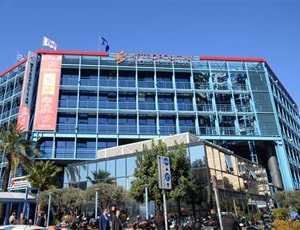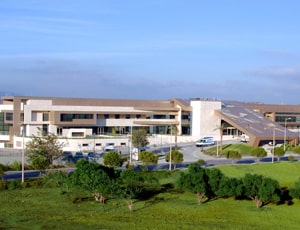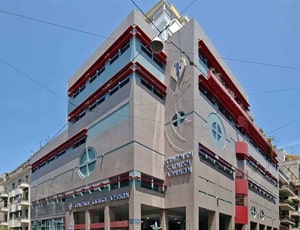The average cost of Hemicolectomy in Pireas approximately starts from USD 37500
Treatment cost

Apart from in-detail treatment procedures available, Metropolitan Hospital located in Pireas, Greece has a wide variety of facilities available for International Patients. Some of the facilities which are provided by them are Accommodation, Airport Transfer, Choice of Meals, Interpreter, SIM, TV inside room. Also listed below are some of the most prominent infrastructural details:


Euromedica General Hospital of Rhodes located in Dodecanese, Greece is accredited by ISO. Also listed below are some of the most prominent infrastructural details:

Central Clinic of Athens located in Athens, Greece is accredited by ISO. Also listed below are some of the most prominent infrastructural details:
The last part of the gastrointestinal system is referred as the colon and it is 5-6 cm long. It is ‘U’ shaped and it starts from the distal part of the small intestine and is connected to the rectum and anus. It absorbs the fluids, processes the metabolic waste products, and eliminates through the rectum and anus. The removal of the colon is called colectomy.
There are different types of colectomies such as complete colectomy, right hemicolectomy, left hemicolectomy, sigmoid colectomy, and proctocolectomy. The surgical removal of the left side of the colon (descending colon) is called left hemicolectomy surgery. The surgical removal of the cecum, ascending colon, and the hepatic flexure (right side of the colon) is called as the right hemicolectomy surgery.
Some of the conditions that require complete colectomy or hemicolectomy surgery include the following:
A hemicolectomy procedure can be performed as a laparoscopic or open surgery. The type of the surgery to be performed is decided by the surgeon during the evaluation and the decision depends on the age and the condition of the patient.
Sometimes the laparoscopic procedure can also be turned into open surgery, depending on the feasibility of the procedure with respect to safety and accuracy. Overall, the following parameters decide whether a laparoscopic or an open surgical procedure will be performed:
You will be informed by your surgeon about the type of surgical procedure that you will benefit you the most. You will be taken to the operating room, and blood pressure and breathing will be monitored.
You will be positioned in lithotomy Trendelenburg (modified Lloyd-Davis) position and your both arms will be abducted on arm boards. The legs will be placed in stirrups and soft padding will be placed underneath to prevent pressure and injuries to the skin and nerves.
After positioning, you will be given general anaesthesia so that you do not feel any pain during the procedure. Sometimes, a peripheral nerve block may also be given to control pain during and after the surgery.
You will be positioned in the supine position initially and later you may be taken to the Trendelenburg position (lying by facing upwards on a tilted bed with pelvis higher than the head).
After positioning, you will be administered general anaesthesia and an additional epidural block for pain management. The catheter will be placed for monitoring the urine output during and after the procedure. The laparoscopic right hemicolectomy procedure or open surgery can be performed, depending on the condition of the colon.
During the hemicolectomy procedure, your surgeon may take any of the following approaches:
Ask your healthcare adviser for the best multiple options and choose the one that meets your expectations
In Pireas, the average starting cost for Hemicolectomy is $37500. While there are wide range of hospitals offering Hemicolectomyation, international patients should always seek JCI-Certified Hospitals in Pireas for the best results.
Hemicolectomy package cost in Pireas has different inclusions and exclusions. The top hospitals for Hemicolectomy in Pireas covers all the expenses related to the pre-surgery investigations of the candidate. The Hemicolectomy package in Pireas includes the fees of the surgeon, hospitalization and anesthesia as well. Stay outside the package duration, port-operative complications and diagnosis of a new condition may further increase the Hemicolectomy cost in Pireas.
There are many hospitals across the country that offer Hemicolectomy to international patients. Some of the best hospitals for Hemicolectomy in Pireasinclude the following:
After discharge from the hospital, the patient has to stay for another 16 days in the country for complete recovery. This period is important to conduct all the follow-up tests to ensure that the surgery was successful and the patient can go back to the home country.
Pireas is undoubtedly one of the best cities for Hemicolectomy in the world. It offers the best medical expertise and good patient experience at an affordable cost. Some of the other top destinations for Hemicolectomy include the following:
Apart from the cost of Hemicolectomy, the patient is also required to pay additionally for daily meals and guest house accommodation. These charges may vary from 50 USD per person.
The patient is supposed to stay at the hospital for about 5 Days after Hemicolectomy surgery for monitoring and care. This time frame is important for the patient to recover properly and feel comfortable after the surgery. With the help of several tests, it is determined that the patient is doing fine after the surgery and is okay to be discharged.
There are more than 1 Hospitals that offer Hemicolectomy in Pireas. These hospitals have the required infrastructure and a decided Hemicolectomy unit where renal failure patients can be treated. Such hospitals follow all legal protocols and guidelines as specified by the local medical affairs body when it comes to the treatment of international patients.